High Antioxidant Foods: Don't Forget Dark Chocolate!
Use this search box to find the info you're looking for!

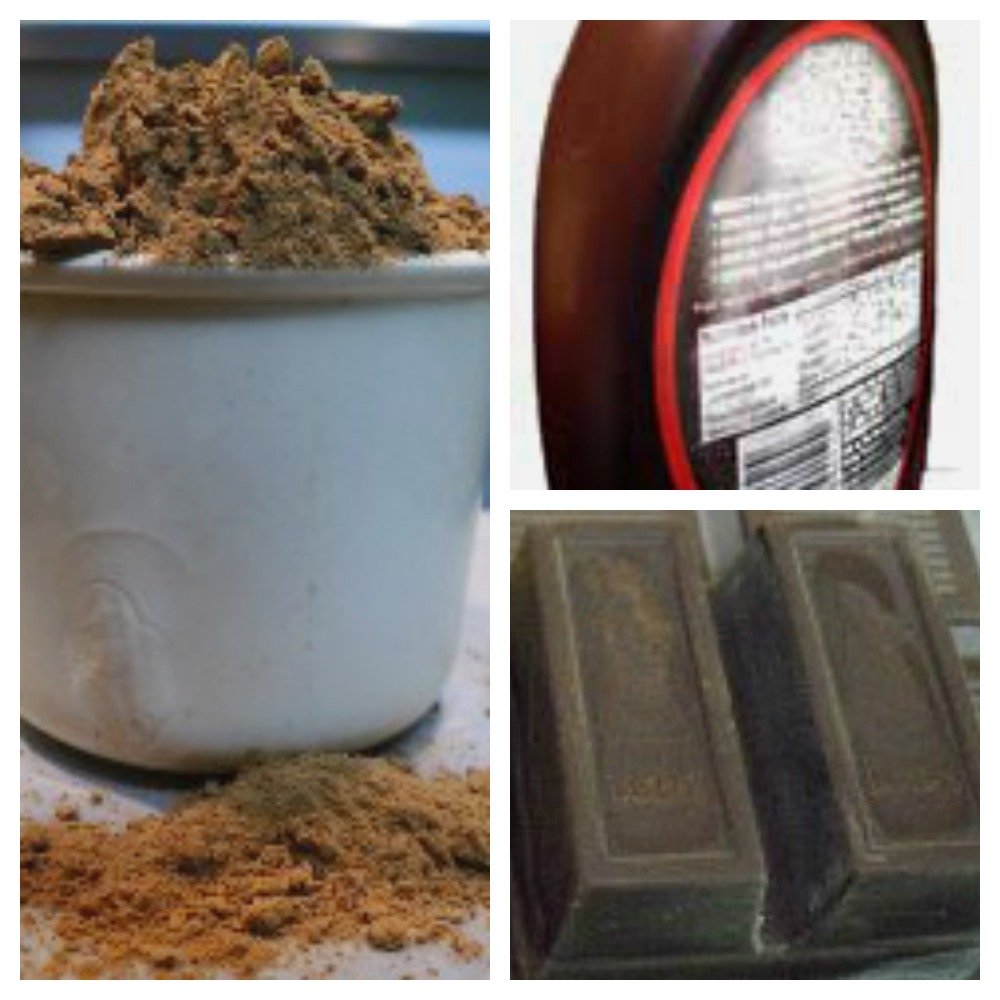
Adding high antioxidant foods to your diet? Don't forget about dark chocolate.
It's an excellent source and way tastier than most other foods. You won't have to force yourself to eat it!
Each dark chocolate product delivers its own dose. So which should you choose? That depends.
Do you want the most antioxidants per bite? Or are you more concerned about taste or convenience?
This handy list will help you decide which dark chocolate products will best meet your objectives.
Peruse it. Use it to maximize your intake of antioxidant foods with minimum effort.
10 Chocolate Sources of Antioxidants
The United States Department of Agriculture, in 2007, published the ORAC Scores of common foods.
What is ORAC? ORAC stands for Oxygen Radical Absorbance Capacity.
It's a way to measure the capacity of a food to fight health-damaging free
radicals. Or so it was thought...
In 2010 the USDA’s Nutrient Data Laboratory (NDL) removed the USDA ORAC Database for Selected Foods from the NDL website. ORAC values are routinely misused by food and dietary supplement manufacturing companies to promote their products and by consumers to guide their food and dietary supplement choices. We know now that antioxidant molecules in food have a wide range of functions, many of which are unrelated to the ability to absorb free radicals.
Ok...now you know what Big Bro thinks. You decide.
The list speaks for itself. Most of the dark chocolate products deliver a big dose of antioxidants. Which, apparently, is still a good thing.
The ORAC scores are per 100 grams or about 3.5 ounces of each food...
- unsweetened cocoa powder-80,933
- unsweetened baking chocolate-49,926
- dutched cocoa powder-40,200
- dark chocolate candies-20,823
- semisweet chocolate candies-18,053
- milk chocolate candies-7,528
- chocolate syrup-6,330
- chocolate milk (reduced fat)-1,263
- cocoa mix-485
These are average scores, not typical. Antioxidant levels can vary for a multitude of reasons.
Still, those are some impressive averages for dark chocolate products!
Remember, the list is meant to be a guide not a guarantee.
You may have noticed that there's only 9 chocolate products in that list. Which one is missing?
Raw chocolate.
It's not a common food so it wasn't tested by the United States Department of Agriculture. But it should be at the top of the list!
Raw Cacao Packs the Most Antioxidants
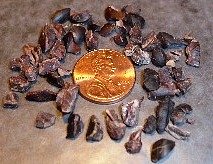
Raw chocolate is the best chocolate source of natural antioxidants. Raw retains it all.
But is it right for you? Maybe, maybe not. It doesn't taste like the highly processed chocolate most of us love. Unsweetened and raw, the taste can be harsh.
But it's such a great source of those polyphenol antioxidants that it's worth a try.
So what do you need to know before you buy?
Select only raw cacao/cocoa beans or nibs that are...
- minimally fermented to preserve nutrients
- as free of fungi and microbes as possible
- from a quality supplier
Like these folks!
Choose raw cacao/cocoa powder that is...
- from a quality supplier
- minimally fermented
- processed at low temperatures-preserves more antioxidants and protects vitamins and minerals that can be destroyed by high heat
Add it to beverages or anything that could use a chocolate boost.Or bake with it. That will probably destroy some of the antioxidants. But there'll be plenty left!
You just might learn to like it. Ok, you may have to force yourself to eat raw chocolate. It's a taste you may have to cultivate but the antioxidants it delivers could be worth it!
These chocolate products are available online and at some health food stores.
More information on raw cocoa nibs and suggested uses.
If raw is too wild for your list of antioxidant foods, try roasted cocoa powder.
Natural Cocoa Powder is Best According to USDA Test
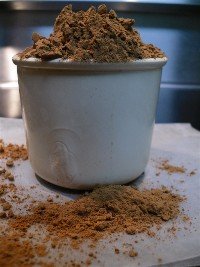
Not ready for raw? Unsweetened cocoa powder is the best chocolate source of antioxidants tested by the USDA.
It has an impressive ORAC score of 80933 per 100 grams or 3.5 ounces.
That works out to about 23,124 per ounce (28g) or 3854 per tablespoon.
That makes it an excellent choice. But it has a major drawback. You can't eat it by itself. So it requires a little work to add it to your diet. But it's worth it.
Use it to bake great desserts or make hot cocoa.
Here are some more delicious ways to use
dark chocolate cocoa powder.
This powerful product is waiting for you at your local store or online. Organic cocoa is available at health food stores or on the net.
Have a favorite brand of chocolate bar like Ghirardelli? Try their cocoa powder.
Try 'em all. Each will have a slightly different flavor.
You'll want this one on your list of antioxidant rich foods.
Unsweetened Baking Chocolate is Second Best

Baking chocolate wallops free radicals with an ORAC score of 49,926 per 100 grams or 3.5 ounces.
That's about 14,264 per square (ounce) or 28g.
Like cocoa powder, unsweetened baking chocolate can't be eaten straight from the box.
Why? Because it's extremely bitter and hard. Discovered that when I was a child.
You can eat semisweet or dark baking chocolate or cooking chocolate right out of the box. Might be a bit hard but it's not raw. The beans have been roasted before they were made into chocolate.
My friends and I found a box of baking chocolate. We couldn't read yet. But we knew chocolate candy when we saw it. Or at least we thought we did. One bite set us straight! Yuck!!!
It's not candy but you can make fantastic baked goods with it. So there's no shortage of ways to use it.
With a little effort, you'll soon be enjoying delicious treats packed with antioxidants!
Believe me, one bite and you'll be glad you made the effort.
But remember to keep it away from your dog.
Dutch Chocolate Cocoa Powder is Third Best
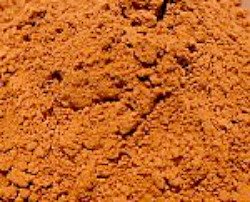
The other cocoa powder. Dutch cocoa powder's ORAC score is 40200 per 100 grams or per 3.5 ounces.
That's about 11486 per ounce (28g), considerably lower than natural cocoa powder.
Why the difference?
Dutch cocoa is treated with an alkali. That darkens it, makes it easier to mix with liquids and mellows the flavor. But it destroys a lot of the antioxidants.
So natural cocoa powder is the better choice of the two antioxidant foods. Gotta work for this one too. Can't eat it by itself.
Use dutched only if you want/need a milder chocolate flavor or if your recipe calls for it. Otherwise go natural!
Dark Chocolate Candies are Fourth Best
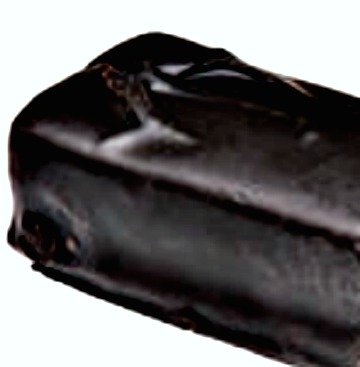
Don't like to bake. Choose dark chocolate candies.
No preparation required. They're highly processed and ready to be popped into your mouth.
Still the ORAC value is pretty impressive at 20823 per 100 grams or per 3.5 ounces or about 5949 per ounce (28g).
Remember, dark in color doesn't automatically mean high in antioxidants. Choose carefully.
Need some pointers, find out what's in the best dark chocolate. Select candy with the highest percentage of cocoa you can.
Think outside the candy aisle. Dark chocolate chips and high cocoa baking bars (with sugar) are also a tasty choice.
A very convenient source add to your list of antioxidant foods.
Semisweet Chocolate Candies are Fifth

Extra dark chocolate too intense? Then you may need to try semisweet.
Semisweet chocolate candies register an ORAC value of 18053 per 100 grams or per 3.5 ounces.
That's about 5158 per ounce (28g).
Not quite as impressive as dark chocolate but still a healthy dose.
Less cocoa means a milder chocolate flavor. Perfect way to get a good dose of antioxidants, if you're not ready for the darker stuff.
Don't forget the semisweet chocolate chips and baking bars. You can eat them like candy. They taste great right from the package, if baking isn't your thing.
One of the most delicious of the chocolate antioxidant foods.
Chocolate Syrup is the Sixth Best Choice for Your Antioxidant Foods List
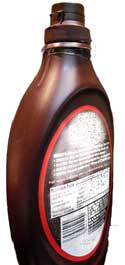
Believe it or not, chocolate syrup has an ORAC value of 6330 per 100 grams or per 3.5 ounces.
That's about 1809 per ounce (28g).
It's not just sweet and gooey. This stuff can actually make a contribution toward your daily intake of those powerful disease fighters. Amazing!
But it also makes a big contribution toward your sugar intake!
Convenient and versatile, you can pour it on anything. Avoid milk, it interferes with the absorption of the dark chocolate antioxidants.
Or so we thought! In 2007, two studies were published that proved that milk does not hinder the body's ability to soak up those precious antioxidants.
Got milk? Go ahead and add some chocolate!
Want to make your own syrup, as dark as you like? Try this dark chocolate syrup recipe .
It's easy to make and you control the flavor. Light, medium or dark, it's your call.
Cocoa Mix is Seventh
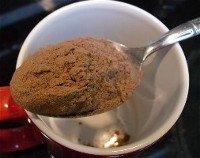
Even your packet of hot cocoa mix can make a small contribution. It came in with an Orac value of 485 per 100 grams or per 3.5 ounces.
That's about 139 per ounce (28g).
Not much but it all adds up.
Better yet, make your own hot drink with cocoa powder for a bigger dose. Try this homemade hot cocoa recipe.
Double Down on Antioxidant Foods
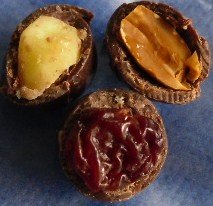
Double up on antioxidants! Eat chocolate covered fruits and/or nuts.
Instead of a gooey center go for the added benefits. Fruits and nuts add nutrients and antioxidants not found in chocolate.
That way you get more nutrition per bite. Make those calories work hard for you!
Here are some excellent fruit choices...
- Cranberries-fiber, vitamin C
- Blueberries-vitamin A, lutein, vitamin K
- Strawberries-vitamins A, C and B-2, folate, potassium, manganese, fiber, iodine
- Cherries-beta carotene, melatonin, potassium, vitamin A
- Raisins-potassium, fiber
- Dates (medjool)-fiber, beta carotene, potassium, vitamin A
Here (in descending order) are your best nut choices...
- Pecans-calcium, copper, folic acid, magnesium, manganese, phosphorus, potassium, vitamins A, B, E and zinc. Heart healthy. Use them to make some homemade chocolate turtles.
- Walnuts-selenium, vitamin A, beta carotene
- Hazelnuts or filberts-calcium, vitamin E
- Pistachios-rich in potassium, phosphorous and magnesium
- Almonds-calcium, copper, magnesium, manganese, potassium, selenium, vitamin E and fiber. Heart healthy.
- Peanuts-niacin, folate, potassium, phosphorus
- Cashew nuts-calcium, copper, iron, magnesium and zinc
- Macadamia nuts-magnesium, potassium, selenium, fiber and protein
- Brazil nuts-phosphorous, calcium, magnesium, potassium selenium, and fiber
These nuts are good for the heart because they're super sources of monounsaturated fats and minerals. And they're cholesterol free!
Plus multiple studies show adding nuts to your diet can reduce your risk of heart disease.
Sources: USDA National Nutrient Database for Standard Reference, Cranberry Institute, and http://urbanext.illinois.edu/strawberries
Now if you can't find some chocolate to add to your list of antioxidant foods something's seriously wrong. Remember, you're supposed to eat a rainbow of colors to get enough healthy free radical fighters. Dark chocolate is your bottomless pot of gold at the end of the rainbow of antioxidant foods!
New! Comments
Feeling the need to send some feedback? Leave me a comment in the box below.